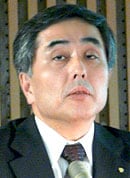[ 2nd Quarter of fiscal 2010 Performance Briefing ]Ceramic Capacitors Business
Mr. Shinichi Araya
Director
Senior Vice President
General Manager
Ceramic Capacitors Business Group
Hello. I'm Shinichi Araya and I would like to report on the first-half performance of TDK's ceramic capacitors business.
Results in the First Half of FY March 2010
First, let me tell you about our accomplishments in the first six months of fiscal 2010. At the beginning of this fiscal year, we experienced a sharp drop-off in orders. At this time, we set the target of improving our operations by consolidating production sites with the aim of integrating our mass production systems. The first quarter saw us complete this integration by consolidating production sites. As we reported at an earlier earnings release conference, we reduced the number of production sites from seven to four. The integrated factories function as core, or Mother Factories, if you will, with two sites producing either general capacitors or large- and high-capacitance capacitors. We also integrated production of application products, so we are now able to manufacture product lines in an integrated manner. I'd like to tell you about the benefits we reaped from this in the first quarter.
Orders have increased steadily and by more than we initially planned. Along with this, in the second quarter we increased production volumes as we worked to raise production efficiency by taking advantage of the benefits of production site consolidation. The slide shows that we achieved larger-than-planned sales. At the previous earnings release conference, we indicated that second-quarter sales would outstrip the first quarter by around 10%. In actuality, the increase was more like 20%.
Site consolidation had a number of benefits for our operations. One was a reduction in fixed costs. Others were reduced production lead times, and a significant improvement in productivity indices, namely, per capita production and per capita sales. As a result, I believe we stripped out the inefficiencies from our production system in the first half of fiscal 2010.
Forecast for the 2nd Half of FY March 2010
Let me tell you how we see the second half playing out. Orders increased quite significantly from the end of the first quarter through the second quarter. The first half saw LCD TV demand rise, particularly in China, while the latter half saw a respectable recovery in auto sector demand. So orders were buoyant. However, orders peaked from around the beginning of the second quarter, including in China. Consequently, as a whole, we don't expect demand to increase as initially projected from the first half to the second half of fiscal 2010.
This flat outlook has shaped our strategy for the second half. Having re-built our production system, we now plan to improve costs and productivity by creating a leaner business structure. I believe that there is still room to improve productivity by at least 10%. In addition to improving our cost structure, we intend to revamp our product mix.
Primary Measures for FY March 2011
Now I will talk about our assumptions for primary measures from the second half of fiscal 2010 through fiscal 2011. One is a change in the competitive landscape. We are assuming competition from Korean manufacturers, not just Japanese. Another assumption is price erosion. There has been no let-up in the sharp fall in prices of products ranging from low-capacitance products to some high-capacitance products. Naturally, the prices of new products have also been pushed down as a result. Because we don't expect a bona fide recovery until around 2010 at the earliest, we will focus on raising the productivity of our production system in the second half of the current fiscal year, as I alluded to before.
That brings me to measures planned for fiscal 2011. We must start making actual preparations for the implementation of these measures from the beginning of the fourth quarter of the current fiscal year. One of those measures is formulation of a production structure to respond swiftly and flexibly to changes in the market. As I said earlier, product mixes and markets are undergoing major change. To stay in step with these changes, we intend to refine our system, including production sites, so that we can supply products more flexibly. Another aim in fiscal 2011 is to develop new products to meet application and market requirements. Looking at our current competitive position in the market, I feel that the fact is we have sometimes fallen slightly behind in terms of the development of new products.
In light of what I have said, we will continue to develop products in areas where we have a competitive edge such as large capacitance and products for automobiles. Equally, we plan to recapture lost ground in certain markets. One of the reasons volumes didn't grow year on year in the second quarter was that TDK didn't compete in the low-priced notebook PC market. However, because the notebook PC market is still experiencing ongoing technological changes, we plan to actively launch new products that address these market developments. Compact, high-capacitance products have seen a large drop in prices, so we will fundamentally review the efficiency of these operations. Overall, by making the production system we established in the first half even leaner in the second half we will position ourselves to take various actions next fiscal year and beyond.


